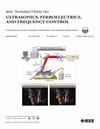Synthetic Lung Ultrasound Data Generation Using Autoencoder With Generative Adversarial Network
IF 3.7
2区 工程技术
Q1 ACOUSTICS
IEEE transactions on ultrasonics, ferroelectrics, and frequency control
Pub Date : 2025-03-27
DOI:10.1109/TUFFC.2025.3555447
引用次数: 0
Abstract
Class imbalance is a significant challenge in medical image analysis, particularly in lung ultrasound (LUS), where severe patterns are often underrepresented. Traditional oversampling techniques, which simply duplicate original data, have limited effectiveness in addressing this issue. To overcome these limitations, this study introduces a novel supervised autoencoder generative adversarial network (SA-GAN) for data augmentation, leveraging advanced generative artificial intelligence (AI) to create high-quality synthetic samples for minority classes. In addition, the traditional data augmentation technique is used for comparison. The SA-GAN incorporates an autoencoder to develop a conditional latent space, effectively addressing weight clipping issues and ensuring higher quality synthetic data. The generated samples are evaluated using similarity metrics and expert analysis to validate their utility. Furthermore, state-of-the-art neural networks are used for multiclass classification, and their performance is compared when trained with GAN-based augmentation versus traditional data augmentation techniques. These contributions enhance the robustness and reliability of AI models in mitigating class imbalance in LUS analysis.基于生成对抗网络的自编码器合成肺超声数据生成。
类别不平衡是医学图像分析的重大挑战,特别是在肺超声(LUS)中,严重的模式往往代表性不足。传统的过采样技术只是简单地复制原始数据,在解决这一问题方面效果有限。为了克服这些限制,本研究引入了一种新的监督式自编码器生成对抗网络(SA-GAN)用于数据增强,利用先进的生成式人工智能为少数族裔创建高质量的合成样本。此外,采用传统的数据增强技术进行比较。SA-GAN集成了一个自动编码器来开发条件潜在空间,有效地解决了权重裁剪问题,并确保了更高质量的合成数据。使用相似性度量和专家分析来评估生成的样本,以验证其效用。此外,采用最先进的神经网络进行多类分类,并比较了基于gan的增强与传统数据增强技术训练时的性能。这些贡献增强了AI模型在缓解LUS分析中的类不平衡方面的鲁棒性和可靠性。
本文章由计算机程序翻译,如有差异,请以英文原文为准。
求助全文
约1分钟内获得全文
求助全文
来源期刊
CiteScore
7.70
自引率
16.70%
发文量
583
审稿时长
4.5 months
期刊介绍:
IEEE Transactions on Ultrasonics, Ferroelectrics and Frequency Control includes the theory, technology, materials, and applications relating to: (1) the generation, transmission, and detection of ultrasonic waves and related phenomena; (2) medical ultrasound, including hyperthermia, bioeffects, tissue characterization and imaging; (3) ferroelectric, piezoelectric, and piezomagnetic materials, including crystals, polycrystalline solids, films, polymers, and composites; (4) frequency control, timing and time distribution, including crystal oscillators and other means of classical frequency control, and atomic, molecular and laser frequency control standards. Areas of interest range from fundamental studies to the design and/or applications of devices and systems.

 求助内容:
求助内容: 应助结果提醒方式:
应助结果提醒方式:


